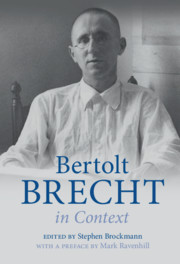Book contents
- Bertolt Brecht in Context
- Bertolt Brecht in Context
- Copyright page
- Contents
- Figure
- Notes on Contributors
- Chronology
- Abbreviations
- Preface
- A Note on Brecht in English
- Introduction
- Part I Brecht’s World
- Part II Brecht’s Work
- Chapter 13 The Work of the Theater
- Chapter 14 Brecht and Marxism
- Chapter 15 Brecht and Photography
- Chapter 16 Brecht and Film: Medium and Masses
- Chapter 17 Brecht and Fiction
- Chapter 18 Gestus in Context
- Chapter 19 Brecht’s Ethics
- Chapter 20 Brecht and Dialectics
- Chapter 21 Brecht and East Asia
- Chapter 22 Brecht’s Work with Musical Composers
- Part III The World’s Brecht
- Concise Bibliography
- Index
Chapter 16 - Brecht and Film: Medium and Masses
from Part II - Brecht’s Work
Published online by Cambridge University Press: 28 May 2021
- Bertolt Brecht in Context
- Bertolt Brecht in Context
- Copyright page
- Contents
- Figure
- Notes on Contributors
- Chronology
- Abbreviations
- Preface
- A Note on Brecht in English
- Introduction
- Part I Brecht’s World
- Part II Brecht’s Work
- Chapter 13 The Work of the Theater
- Chapter 14 Brecht and Marxism
- Chapter 15 Brecht and Photography
- Chapter 16 Brecht and Film: Medium and Masses
- Chapter 17 Brecht and Fiction
- Chapter 18 Gestus in Context
- Chapter 19 Brecht’s Ethics
- Chapter 20 Brecht and Dialectics
- Chapter 21 Brecht and East Asia
- Chapter 22 Brecht’s Work with Musical Composers
- Part III The World’s Brecht
- Concise Bibliography
- Index
Summary
This chapter examines Brecht’s approach to film not as a mimetic means of reproducing reality but as an indexical means of producing reality. It considers key passages of “The Threepenny Trial” and several interwar fragments in order to elucidate Brecht’s distinction between actual and functional reality and to elaborate the concept of the cognitively capable masses, whose collective perception made recognition of actual reality possible. It then offers brief analyses of the key films Brecht worked on, Kuhle Wampe and Hangmen Also Die!, which provide examples of the strategies Brecht employed to bend film to his aims of modeling mass-based cognition and reality production. These attempts opposed industrial norms, cultural convention, and the regulatory force of the state. They succeeded infrequently if at all, as Brecht himself acutely realized. Assessing the success and failure of these experiments allows greater insight into the potential of the medium of film in the second quarter of the twentieth century and creates potentially useful points of comparison to the complex relationship between representational media and the networked production of reality in our own times.
Keywords
- Type
- Chapter
- Information
- Bertolt Brecht in Context , pp. 140 - 148Publisher: Cambridge University PressPrint publication year: 2021

